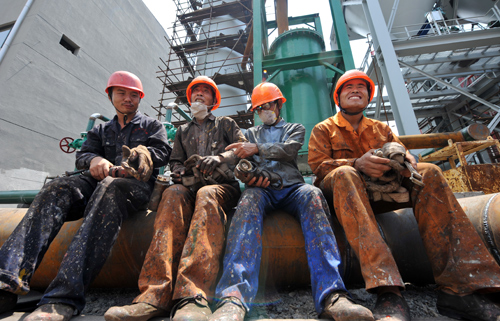|
 |
|
CITY BUILDERS: Migrant workers take rest at a construction site in Beilun Power Plant in Ningbo City, Zhejiang Province, on August 11, 2011 (WANG DINGXU) |
For the first time in history China's urban population will exceed its rural population at the beginning of 2012, according to the 2011 Blue Book on China's Society.
"It will be a significant turning point for China, changing a thousand-year-old majority agrarian and rural population structure," said the blue book, which was released by the Chinese Academy of Social Sciences (CASS) last December. It attributed the change to rapid urbanization.
According to results of the latest nationwide population census, there were 665 million urban residents on the Chinese mainland, or 49.68 percent of the total national population, on November 1, 2010.
"The reversal not only indicates a simple alteration in the percentage of the urban
population, but also implies profound changes in Chinese people's lifestyles, employment, consumption and even values, which will have profound impacts on the economy and society as a whole," said Li Peilin, Director of the Institute of Sociology of the CASS.
Along with the change of the proportion of urban and rural residents, economists believe the emergence of a fundamentally urban society will inject tremendous vitality into the Chinese economy.
Urbanization has long been considered an engine for progress, because it creates new demands and these demands propel the economy forward.
However, the extent of China's urbanization is still open to question. China has counted migrants staying six months or more as part of the resident population of a city since 2005. But physically living and working in a city does not necessarily allow rural migrants to get urban hukou (permanent residence registration) under the current regime in China.
According to the blue book, there are more than 240 million rural migrants in Chinese cities.
The majority of these rural migrants work as temporary construction workers and in the service industry. But they are effectively excluded from the social security and welfare guarantees that are only available to people with urban hukou, and have to pay much more for their children's schooling in cities.
"This may lead to social conflicts and increase social instability," said Li Tie, Director of the China Center for Urban Development.
In order to tackle these challenges, many scholars have called on the government to adopt new policies and social management approaches to help rural migrants assimilate into cities.
Rapid economic growth and better job opportunities in cities are the main factors behind growth in the country's urbanization rate, which has risen from about 18 percent in 1978 to around 50 percent today.
| 